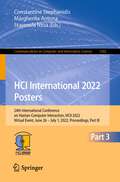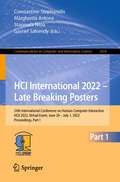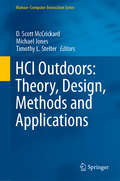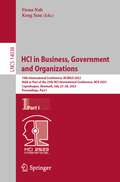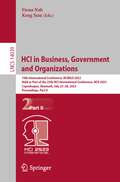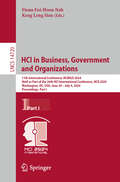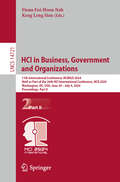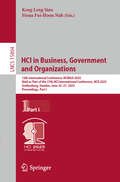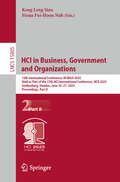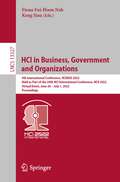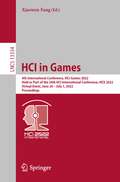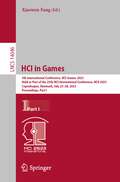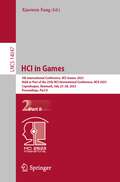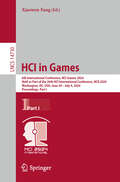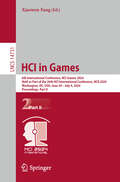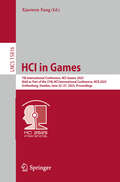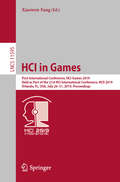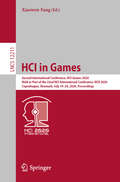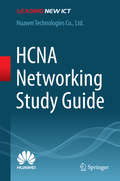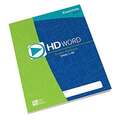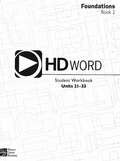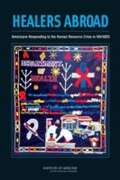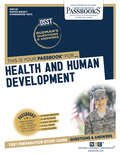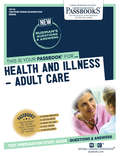- Table View
- List View
HCI International 2022 Posters: 24th International Conference on Human-Computer Interaction, HCII 2022, Virtual Event, June 26 – July 1, 2022, Proceedings, Part III (Communications in Computer and Information Science #1582)
by Margherita Antona Constantine Stephanidis Stavroula NtoaThe four-volume set CCIS 1580, CCIS 1581, CCIS 1582, and CCIS 1583 contains the extended abstracts of the posters presented during the 24th International Conference on Human-Computer Interaction, HCII 2022, which was held virtually in June - July 2022. The total of 1276 papers and 275 posters included in the 40 HCII 2021 proceedings volumes was carefully reviewed and selected from 5583 submissions.The posters presented in these four volumes are organized in topical sections as follows: Part I: user experience design and evaluation; visual design and visualization; data, information and knowledge; interacting with AI; universal access, accessibility and design for aging. Part II: multimodal and natural interaction; perception, cognition, emotion and psychophysiological monitoring; human motion modelling and monitoring; IoT and intelligent living environments. Part III: learning technologies; HCI, cultural heritage and art; eGovernment and eBusiness; digital commerce and the customer experience; social media and the metaverse. Part IV: virtual and augmented reality; autonomous vehicles and urban mobility; product and robot design; HCI and wellbeing; HCI and cybersecurity.
HCI International 2022 – Late Breaking Posters: 24th International Conference on Human-Computer Interaction, HCII 2022, Virtual Event, June 26 – July 1, 2022, Proceedings, Part I (Communications in Computer and Information Science #1654)
by Gavriel Salvendy Margherita Antona Constantine Stephanidis Stavroula NtoaVolume CCIS 1654 is part of the refereed proceedings of the 24th International Conference on Human-Computer Interaction, HCII 2022, which was held virtually during June 26 to July 1, 2022. A total of 5583 individuals from academia, research institutes, industry, and governmental agencies from 88 countries submitted contributions, and 1276 papers and 275 posters were included in the proceedings that were published just before the start of the conference. Additionally, 296 papers and 181 posters are included in the volumes of the proceedings published after the conference, as “Late Breaking Work” (papers and posters). The contributions thoroughly cover the entire field of human-computer interaction, addressing major advances in knowledge and effective use of computers in a variety of application areas.
HCI Outdoors: Theory, Design, Methods and Applications (Human–Computer Interaction Series)
by Michael Jones D. Scott McCrickard Timothy L. StelterAdvances in network connectivity, power consumption, and physical size create new possibilities for using interactive computing outdoors. However, moving computing outdoors can drastically change the human outdoor experience. This impact is felt in many kinds of outdoor activities such as citizen science, personal recreation, search and rescue, informal education, and others. It is also felt across outdoor settings that range from remote wilderness to crowded cities. Understanding these effects can lead to ideas, designs and systems that improve, rather than diminish, outdoor experiences. This book represents the current results emerging from recent workshops focused on HCI outdoors and held in conjunction with CHI, GROUP, UbiComp, and MobileHCI conferences. Based on feedback at those workshops, and outreach to other leaders in the field, the chapters collected were crafted to highlight methods and approaches for understanding how technologies such as handhelds, wearables, and installed standalone devices impact individuals, groups, and even communities. These findings frame new ways of thinking about HCI outdoors, explore logistical issues associated with moving computing outdoors, and probe new experiences created by involving computing in outdoor pursuits. Also important are the ways that social media has influenced preparation, experience, and reflection related to outdoor experiences. HCI Outdoors: Theory, Design, Methods and Applications is of interest to HCI researchers, HCI practitioners, and outdoor enthusiasts who want to shape future understanding and current practice related to technology in every kind of outdoor experience.
HCI in Business, Government and Organizations: 10th International Conference, HCIBGO 2023, Held as Part of the 25th HCI International Conference, HCII 2023, Copenhagen, Denmark, July 23–28, 2023, Proceedings, Part I (Lecture Notes in Computer Science #14038)
by Keng Siau Fiona NahThis two-volume set of HCIBGO 2023, constitutes the refereed proceedings of the 10h International Conference on HCI in Business, Government and Organizations, held as Part of the 24th International Conference, HCI International 2023, which took place in July 2023 in Copenhagen, Denmark.The total of 1578 papers and 396 posters included in the HCII 2023 proceedings volumes was carefully reviewed and selected from 7472 submissions. The HCIBGO 2023 proceedings focuses in topics such as artificial intelligence and machine learning, blockchain, service design, live streaming in electronic commerce, visualization, and workplace design.
HCI in Business, Government and Organizations: 10th International Conference, HCIBGO 2023, Held as Part of the 25th HCI International Conference, HCII 2023, Copenhagen, Denmark, July 23–28, 2023, Proceedings, Part II (Lecture Notes in Computer Science #14039)
by Keng Siau Fiona NahThis two-volume set of HCIBGO 2023, constitutes the refereed proceedings of the 10h International Conference on HCI in Business, Government and Organizations, held as Part of the 24th International Conference, HCI International 2023, which took place in July 2023 in Copenhagen, Denmark.The total of 1578 papers and 396 posters included in the HCII 2023 proceedings volumes was carefully reviewed and selected from 7472 submissions. The HCIBGO 2023 proceedings focuses in topics such as artificial intelligence and machine learning, blockchain, service design, live streaming in electronic commerce, visualization, and workplace design.
HCI in Business, Government and Organizations: 11th International Conference, HCIBGO 2024, Held as Part of the 26th HCI International Conference, HCII 2024, Washington, DC, USA, June 29 – July 4, 2024, Proceedings, Part I (Lecture Notes in Computer Science #14720)
by Fiona Fui-Hoon Nah Keng Leng SiauThis two-volume set of HCIBGO 2024 constitutes the refereed proceedings of the 11h International Conference on HCI in Business, Government and Organizations, held as part of the 26th International Conference, HCI International 2024, which took place in from June 29 - July 4, 2024 in Washington DC, USA. Two volumes of the HCII 2024 proceedings are dedicated to this year’s edition of the HCIBGO conference. The first covers topics related to Digital Commerce and Marketing, Artificial Intelligence in Business, and Workplace, Well-being and Productivity. The second focuses on topics related to Teleworking and Virtual Collaboration, and Improving User Experience and Service Efficiency.
HCI in Business, Government and Organizations: 11th International Conference, HCIBGO 2024, Held as Part of the 26th HCI International Conference, HCII 2024, Washington, DC, USA, June 29 – July 4, 2024, Proceedings, Part II (Lecture Notes in Computer Science #14721)
by Fiona Fui-Hoon Nah Keng Leng SiauThis two-volume set of HCIBGO 2024 constitutes the refereed proceedings of the 11h International Conference on HCI in Business, Government and Organizations, held as part of the 26th International Conference, HCI International 2024, which took place in from June 29 - July 4, 2024 in Washington DC, USA. Two volumes of the HCII 2024 proceedings are dedicated to this year’s edition of the HCIBGO conference. The first covers topics related to Digital Commerce and Marketing, Artificial Intelligence in Business, and Workplace, Well-being and Productivity. The second focuses on topics related to Teleworking and Virtual Collaboration, and Improving User Experience and Service Efficiency.
HCI in Business, Government and Organizations: 12th International Conference, HCIBGO 2025, Held as Part of the 27th HCI International Conference, HCII 2025, Gothenburg, Sweden, June 22–27, 2025, Proceedings, Part I (Lecture Notes in Computer Science #15804)
by Fiona Fui-Hoon Nah Keng Leng SiauThis two-volume set of HCIBGO 2025 constitutes the refereed proceedings of the 12th International Conference on HCI in Business, Government and Organizations, held as part of the 27th International Conference, HCI International 2025, which took place in Gothenburg, Sweden, during June 22–27, 2025. Two volumes of the HCII 2025 proceedings are dedicated to this year&’s edition of the HCIBGO conference. The first volume covers topics related to User Experience, Design, and Digital Engagement; Artificial Intelligence in Digital Transformation and Business Processes; and Social Media and Market Insights. The second volume focuses on topics related to Roles, Skills, and Technology Adoption in Modern Workplaces; and Collaboration, Communication, and Work Dynamics.
HCI in Business, Government and Organizations: 12th International Conference, HCIBGO 2025, Held as Part of the 27th HCI International Conference, HCII 2025, Gothenburg, Sweden, June 22–27, 2025, Proceedings, Part II (Lecture Notes in Computer Science #15805)
by Fiona Fui-Hoon Nah Keng Leng SiauThis two-volume set of HCIBGO 2025 constitutes the refereed proceedings of the 12th International Conference on HCI in Business, Government and Organizations, held as part of the 27th International Conference, HCI International 2025, which took place in Gothenburg, Sweden, during June 22–27, 2025. Two volumes of the HCII 2025 proceedings are dedicated to this year&’s edition of the HCIBGO conference. The first volume covers topics related to User Experience, Design, and Digital Engagement; Artificial Intelligence in Digital Transformation and Business Processes; and Social Media and Market Insights. The second volume focuses on topics related to Roles, Skills, and Technology Adoption in Modern Workplaces; and Collaboration, Communication, and Work Dynamics.
HCI in Business, Government and Organizations: 9th International Conference, HCIBGO 2022, Held as Part of the 24th HCI International Conference, HCII 2022, Virtual Event, June 26 – July 1, 2022, Proceedings (Lecture Notes in Computer Science #13327)
by Fiona Fui-Hoon Nah Keng SiauThis book constitutes the refereed proceedings of the 9th International Conference on HCI in Business, Government and Organizations, HCIBGO 2022, held as part of the 23rd International Conference, HCI International 2022, which was held virtually in June/July 2022. The total of 1271 papers and 275 posters included in the HCII 2022 proceedings was carefully reviewed and selected from 5487 submissions. The HCIBGO 2022 proceedings focuses in topics such as artificial intelligence and machine learning, blockchain, service design, live streaming in electronic commerce, visualization, and workplace design.
HCI in Games: 4th International Conference, HCI-Games 2022, Held as Part of the 24th HCI International Conference, HCII 2022, Virtual Event, June 26–July 1, 2022, Proceedings (Lecture Notes in Computer Science #13334)
by Xiaowen FangThis book constitutes the refereed proceedings of the 4th International Conference on HCI in Games, HCI in Games 2022, held as part of the 23rd International Conference, HCI International 2022, which was held virtually in June/July 2022. The total of 1271 papers and 275 posters included in the HCII 2022 proceedings was carefully reviewed and selected from 5487 submissions. The HCI in Games 2022 proceedings intends to help, promote and encourage research in this field by providing a forum for interaction and exchanges among researchers, academics, and practitioners in the fields of HCI and games. The Conference addresses HCI principles, methods and tools for better games.
HCI in Games: 5th International Conference, HCI-Games 2023, Held as Part of the 25th HCI International Conference, HCII 2023, Copenhagen, Denmark, July 23–28, 2023, Proceedings Part I (Lecture Notes in Computer Science #14046)
by Xiaowen FangThis two-volume set of HCI-Games 2023, constitutes the refereed proceedings of the 5th International Conference on HCI in Games, held as Part of the 24th International Conference, HCI International 2023, which took place in July 2023 in Copenhagen, Denmark.The total of 1578 papers and 396 posters included in the HCII 2023 proceedings volumes was carefully reviewed and selected from 7472 submissions. The HCI in Games 2023 proceedings intends to help, promote and encourage research in this field by providing a forum for interaction and exchanges among researchers, academics, and practitioners in the fields of HCI and games. The Conference addresses HCI principles, methods and tools for better games.
HCI in Games: 5th International Conference, HCI-Games 2023, Held as Part of the 25th HCI International Conference, HCII 2023, Copenhagen, Denmark, July 23–28, 2023, Proceedings, Part II (Lecture Notes in Computer Science #14047)
by Xiaowen FangThis two-volume set of HCI-Games 2023, constitutes the refereed proceedings of the 5th International Conference on HCI in Games, held as Part of the 24th International Conference, HCI International 2023, which took place in July 2023 in Copenhagen, Denmark.The total of 1578 papers and 396 posters included in the HCII 2023 proceedings volumes was carefully reviewed and selected from 7472 submissions. The HCI in Games 2023 proceedings intends to help, promote and encourage research in this field by providing a forum for interaction and exchanges among researchers, academics, and practitioners in the fields of HCI and games. The Conference addresses HCI principles, methods and tools for better games.
HCI in Games: 6th International Conference, HCI-Games 2024, Held as Part of the 26th HCI International Conference, HCII 2024, Washington, DC, USA, June 29–July 4, 2024, Proceedings, Part I (Lecture Notes in Computer Science #14730)
by Xiaowen FangThis book constitutes the refereed proceedings of the 6th International Conference on HCI in Games, held as part of the 26th International Conference, HCI International 2024, which took place in Washington DC, USA, during June 29 - July 4, 2024. The total of 1271 papers and 309 posters included in the HCII 2024 proceedings was carefully reviewed and selected from 5108 submissions. The two volume set of HCI-Games 2024 proceedings were organized in the following topical sections: Volume 14730: Part I: Game Design and Gamification; Part II: Game-based Learning; Part III: Games and Artificial Intelligence Volume 14731: Part I: Advancing Education Through Serious Games; Part II: Player Experience and Engagement
HCI in Games: 6th International Conference, HCI-Games 2024, Held as Part of the 26th HCI International Conference, HCII 2024, Washington, DC, USA, June 29–July 4, 2024, Proceedings, Part II (Lecture Notes in Computer Science #14731)
by Xiaowen FangThis book constitutes the refereed proceedings of the 6th International Conference on HCI in Games, held as part of the 26th International Conference, HCI International 2024, which took place in Washington DC, USA, during June 29 - July 4, 2024. The total of 1271 papers and 309 posters included in the HCII 2024 proceedings was carefully reviewed and selected from 5108 submissions. The two volume set of HCI-Games 2024 proceedings were organized in the following topical sections: Volume 14730: Part I: Game Design and Gamification; Part II: Game-based Learning; Part III: Games and Artificial Intelligence. Volume 14731: Part I: Advancing Education Through Serious Games; Part II: Player Experience and Engagement.
HCI in Games: 7th International Conference, HCI-Games 2025, Held as Part of the 27th HCI International Conference, HCII 2025, Gothenburg, Sweden, June 22–27, 2025, Proceedings (Lecture Notes in Computer Science #15816)
by Xiaowen FangThis book constitutes the refereed proceedings of the 7th International Conference on HCI in Games, held as part of the 27th International Conference, HCI International 2025, which took place in Gothenburg, Sweden, during June 22–27, 2025. The total of 1430 papers and 355 posters included in the HCII 2025 proceedings was carefully reviewed and selected from thousands of submissions. The HCI-Games 2025 proceedings was organized in the following topical sections: Part 1: Gamification, UX, and Player BehaviorPart 2: Identity, Emotion, and AI in Game ExperiencesPart 3: Gamified Learning and DesignPart 4: Games in Healthcare and Wellbeing
HCI in Games: First International Conference, HCI-Games 2019, Held as Part of the 21st HCI International Conference, HCII 2019, Orlando, FL, USA, July 26–31, 2019, Proceedings (Lecture Notes in Computer Science #11595)
by Xiaowen FangThis book constitutes the refereed proceedings of the First International Conference on HCI in Games, HCI-Games 2019, held in July 2019 as part of HCI International 2019 in Orlando, FL, USA. HCII 2019 received a total of 5029 submissions, of which 1275 papers and 209 posters were accepted for publication after a careful reviewing process. The 34 papers presented in this volume are organized in topical sections named: Game Design; Gaming Experience; Serious Games; and Gamification.
HCI in Games: Second International Conference, HCI-Games 2020, Held as Part of the 22nd HCI International Conference, HCII 2020, Copenhagen, Denmark, July 19–24, 2020, Proceedings (Lecture Notes in Computer Science #12211)
by Xiaowen FangThis book constitutes the refereed proceedings of the Second International Conference on HCI in Games, HCI-Games 2020, held in July 2020 as part of HCI International 2020 in Copenhagen, Denmark.* HCII 2020 received a total of 6326 submissions, of which 1439 papers and 238 posters were accepted for publication after a careful reviewing process. The 38 papers presented in this volume are organized in topical sections named: designing games and gamified interactions; user engagement and game impact; and serious games. *The conference was held virtually due to the COVID-19 pandemic.
HCNA Networking Study Guide
by Ltd. Huawei Technologies Co.This book is a study guide for Huawei (HCNA) certification. It has been written to help readers understand the principles of network technologies. It covers topics including network fundamentals, Ethernet, various protocols such as those used in routing, and Huawei's own VRP operating system--all essential aspects of HCNA certification. Presenting routing and switching basics in depth, it is a valuable resource for information and communications technology (ICT) practitioners, university students and network technology fans.
HD Word Essentials Student Workbook 1 UNITS 1 to 20
by Really Great Reading CompanyReally Great Reading Company STUDENT WORKBOOK 1 UN
HD Word Essentials Student Workbook 2 (Grades 5-8) UNITS 21-33
by Really Great Reading CompanyHD Word, Essentials Student Workbook 2 (Grades 5-8) UNITS 21-33
HDR Photography Photo Workshop
by Peter Carr Robert CorrellLearn the intricacies of High Dynamic Range photography from experts and get feedback on your workHigh Dynamic Range (HDR) photography offers a new range of creative possibilities to the photographer who is skilled in the technique. HDR requires specific camera skills as well as the use of specialized software, and the photographers who wrote this book are experts in both. They explain the process of shooting the same subject at different exposures, combining those shots into a single HDR image, fine-tuning brightness and contrast, minimizing noise, layering images, and more, including creative techniques with Photoshop and Lightroom.You can submit your HDR images for feedback at photoworkshop.com.High Dynamic Range (HDR) photography offers creative possibilities through specific camera and software techniques that produce highly detailed and imaginative imagesTwo professional photographers team up to provide expert instruction in HDR camera and software techniques for those new to HDRCovers the latest software and concepts, a comprehensive exploration of HDR basics, various techniques for shooting and merging images, and creative tricks with Photoshop and LightroomLavishly illustrated with new examples and full of suggestions for developing a personal HDR styleStudents can upload their own images for feedback at photoworkshop.comAny photographer who is new to HDR will find this guide loaded with helpful instructions and encouraging advice.
HEALERS ABROAD: Americans Responding to the Human Resource Crisis in HIV/AIDS
by Committee on the Options for Overseas Placement of U.S. Health ProfessionalsHealers Abroad: Americans Responding to the Human Resource Crisis in HIV/AIDS calls for the federal government to create and fund the United States Global Health Service (GHS) to mobilize the nation’s best health care professionals and other highly skilled experts to help combat HIV/AIDS in hard-hit African, Caribbean, and Southeast Asian countries. The dearth of qualified health care workers in many lowincome nations is often the biggest roadblock to mounting effective responses to public health needs. The proposal’s goal is to build the capacity of targeted countries to fight the HIV/AIDS pandemic over the long run. The GHS would be comprised of six multifaceted components. Full-time, salaried professionals would make up the organization’s pivotal “service corps,” working side-by-side with other colleagues already on the ground to provide medical care and drug therapy to affected populations while offering local counterparts training and assistance in clinical, technical, and managerial areas.
HEALTH AND HUMAN DEVELOPMENT: Passbooks Study Guide (DANTES Subject Standardized Tests (DSST))
by National Learning CorporationThe DSST Subject Standardized Tests are comprehensive college and graduate level examinations given by the Armed Forces, colleges and graduate schools. These exams enable students to earn college credit for what they have learned through self-study, on the job, or by other non-traditional means. The DSST Health and Human Development Passbook® prepares candidates for the DSST exam, which enables schools to award credit for knowledge acquired outside the normal classroom environment. It provides a series of informational texts as well as hundreds of questions and answers in the areas that will likely be covered on your upcoming exam, including but not limited to: health and wellness; human development; fitness and nutrition; diseases and disease prevention; addiction; and more.
HEALTH AND ILLNESS – ADULT CARE: Passbooks Study Guide (Certified Nurse Examination Series)
by National Learning CorporationThe Certified Nurse Examination Series prepares individuals for licensing and certification conducted by the American Nurses Credentialing Center (ANCC), the National Certification Corporation (NCC), the National League for Nursing (NLN), and other organizations. The HEALTH AND ILLNESS – ADULT CARE Passbook® provides a series of informational texts as well as hundreds of questions and answers in the areas that will likely be covered on your upcoming exam.
